Fred Mazelis
The Left Front: Radical Art in the ‘Red Decade,’ 1929-1940, at the Grey Art Gallery, New York University, New York City, January 13-April 4, 2015
The exhibition currently on view at New York University’s Grey Art Gallery is indeed an ambitious one. Entitled “The Left Front: Radical Art in the ‘Red Decade,’ 1929-1940,” it presents the work of dozens of American artists, both immigrant and native-born, who were radicalized in this period of the Depression, revolutionary struggle, the rise of fascism and the looming threat of world war.
The show, consisting of about 100 works by 40 artists, originated in the Chicago area at the Mary and Leigh Block Museum of Art at Northwestern University. It has been enlarged and expanded at NYU, using books, periodicals, photographs and film from the university’s well-known Tamiment Library, with its important holdings on the history of the socialist and labor movements in the US.
Much of the Grey Gallery exhibition consists of lithographs and other prints, in line with the emphasis of these artists on producing work for a mass audience instead of wealthy patrons or the art market. Many of the artists are not well-known, although the names of Louis Lozowick, Kenneth Hayes Miller, Rockwell Kent, Isabel Bishop, Raphael Soyer and especially Stuart Davis will be more familiar to those acquainted with 20th century American art.
The show examines the work of politically conscious artists in the period between the 1929 Wall Street Crash and the Second World War. This is undoubtedly an important subject, both for art-historical and aesthetic as well as political reasons. As the director of the Block Museum notes in the extensive guide to the show, “In light of the recent global recession, the study of artworks created by artist-activists in the 1930s provides a crucial historical backdrop for understanding artists’ responses to moments of social, political and economic crisis—then and now.”
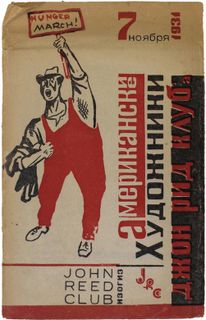 ‘American Artists of the John Reed Club’ (1931) in ‘The Left Front.’ Photo: Amherst Center for Russian Culture/Amherst College
‘American Artists of the John Reed Club’ (1931) in ‘The Left Front.’ Photo: Amherst Center for Russian Culture/Amherst College
Unfortunately, the historical backdrop is not seriously and truthfully explored. While it is certainly worthwhile to view many of these works, an in-depth presentation must surely go beyond the fairly obvious issue of what immediately propelled these artists to take up their work.
What were the social and historical circumstances that moved them to come around the John Reed Clubs? The JRC were initiated by the US Communist Party in 1929 and named after the famed American journalist and Communist, the subject of the movie Reds, who wrote the classic account of the October 1917 revolution, Ten Days That Shook the World (1919), and died of typhus in the Soviet Union in 1920.
What was the role of the Communist Party, to which most of these artists gravitated, during this period? How was the work of these artists affected by the events of the 1930s? What became of the “Left Front”? (The title of the show is taken from the name of a short-lived Chicago-based art magazine in the early 1930s, but the curators are applying it to a broader movement during this decade.). What was the significance of the aesthetic issues these artists wrestled with, and how were they related to the struggles within the Soviet Union on “proletarian culture” and “proletarian art”? On these issues the NYU exhibit is often superficial where it is not misleading.
Either because it is too demanding, or perhaps because it cuts too close to the political bone, the curators fail to confront the centrality of the rise of Stalinism and Trotsky’s fight against the bureaucracy to 20th century cultural life. The artists under consideration in the present show were not the product of some relatively “organic” or contradiction-free left-wing artistic development, as the exhibition suggests. The movement the artists adhered to, the Communist Party, had suffered a fatal degeneration by the mid-1930s, and, in fact, was dominated by anti-Marxist conceptions about art and society.
The classical Marxist tradition of Plekhanov, Trotsky, Voronsky and others, which insisted upon the objective character of artistic cognition, had been repudiated by a petty bourgeois bureaucracy in the CPUSA and the Stalinist movement internationally that was hostile to the independent movement of the working class and frightened of genuinely challenging artistic work. Within the American CP, the Marxist conception that culture should enlighten and uplift the mass of the population through a determined struggle was rejected, in favor of an adaptation to national-populist traditions, generally empty rhetoric about art as “a weapon” and uncritical allegiance to the Soviet bureaucracy.
 Georgi Plekhanov
Georgi Plekhanov
Most of the artists represented here associated themselves with the conception of “proletarian art.” This false theory, which attracted much support in the years after the 1917 Revolution, proceeded from an abstract and formal identity between art and politics. It denounced most of the art of the past as “bourgeois” and therefore reactionary, and announced, in a leap that was the antithesis of Marxism, that the working class now had to create—laboratory-style—its own art.
Both Lenin and Trotsky bitterly opposed these views. Trotsky argued inLiterature and Revolution (1924) and many other writings and speeches that the art of the future would be socialist, not proletarian art, and that the proletariat, as an oppressed class, had to assimilate the cultural achievements of the past in the building of a new, classless society.
The debate over proletarian art played a significant role in the growing nationalist degeneration of the Russian Revolution, fought by the Trotskyist Left Opposition. “Proletarian culture” was utilized, especially after Lenin’s death, by the conservative bureaucracy under Stalin. It became part of the repudiation of socialist internationalism. The Stalinists used the slogan to justify an indefinite period of rule by the national-opportunist bureaucracy.
Opposing the rejection of past culture, Trotsky wrote, “It would be monstrous to conclude…that the technique of bourgeois art is not necessary to the workers. Yet there are many who fall into this error. ‘Give us,’ they say, ‘something even pock-marked, but our own.’ This is false and untrue. A pock-marked art is not art and is therefore not necessary to the working class. Those who believe in a ‘pock-marked’ art are imbued to a considerable extent with contempt for the masses and are like the breed of politicians who have no faith in class power but who flatter and praise the class when ‘all is well.’”
This was not, of course, an argument against realism in art or in literature, but rather the insistence that realism and naturalism had to be genuine, not based on flattery and an unreal idealization of the working class or anyone else. Trotsky argued that the artist who genuinely devoted him- or herself to the struggle against capitalist exploitation had to grasp the dialectical relationship between image and reality.
Trotsky’s opposition to “proletarian art” was an eloquent answer to the attempt to straitjacket literature and art. As he wrote in 1938, “Truly intellectual creation is incompatible with lies, hypocrisy and the spirit of conformism. Art can become a strong ally of revolution only insofar as it remains faithful to itself.”
These issues are not seriously addressed in the exhibition, although they come in for one or two brief mentions. In fact, although Trotsky wrote voluminously on the subject of socialism and culture, the quote in the above paragraph is the only mention of his views, and it is almost buried inside a glass case alongside a copy of one of the early issues of Partisan Review, the magazine founded by anti-Stalinist intellectuals who briefly flirted with Trotskyism in the late 1930s.
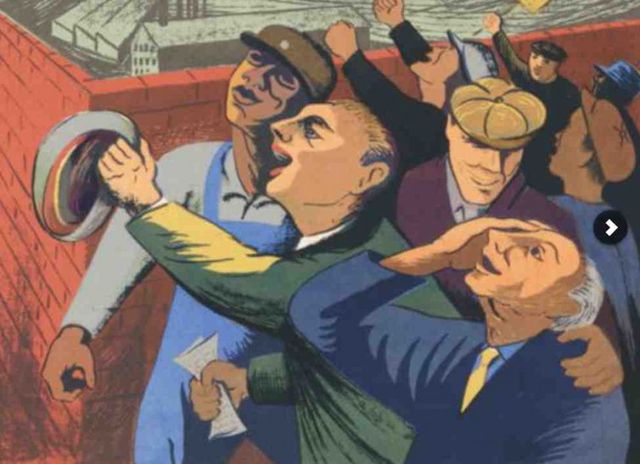 Harry Gottlieb (American, b. Bucharest, Romania, 1892-1992), "The Strike is Won," 1940. Color screenprint, 12 1/4 x 16 1/2 in. Collection of Belverd and Marion Needles
Harry Gottlieb (American, b. Bucharest, Romania, 1892-1992), "The Strike is Won," 1940. Color screenprint, 12 1/4 x 16 1/2 in. Collection of Belverd and Marion Needles
There is more than a bit of “pock-marked” art in The Left Front. Even if many of these artists were well-meaning, their work exhibits little of the “faith in class power” that Trotsky referred to.
Several examples stand out, especially among the artists based in Chicago who perhaps were under the influence of a syndicalist outlook in that industrial center, which in turn reinforced the doctrine of proletarian art.
Morris Topchevsky (1899-1947), a prolific artist active in Chicago, is represented by a number of works in this show, including Strike Against Wage Cuts (1930), a watercolor and pencil sketch that is little more than an idealized depiction of workers being addressed by a strike leader. A lithograph by Harry Gottlieb (1895-1992), The Strike Is Won (1937) is even more in the tradition of Stalinist socialist realism, with its lifeless portrayal of saintly workers and upturned faces.
There is little that is genuine and nothing that is revolutionary about these works and a number of others along similar lines in the exhibit. These include Mitchell Siporin’s (1910-1976) watercolor Spanish Civil War (after Goya), an unimaginative transposition of Goya’s famous The Third of May, 1808, the depiction of Spanish resistance to Napoleonic occupation, to the Spanish Civil War of the late 1930s.
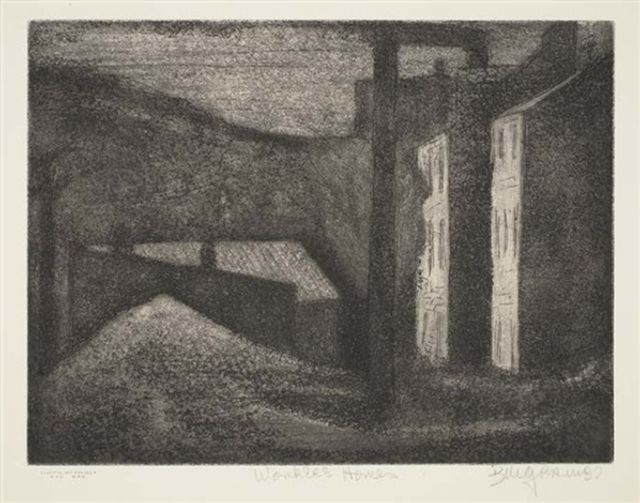 Blanche Grambs (American, b. Beijing, China, 1916-), "Workers' homes," 1937-38. Etching and aquatint, 9 x 11.7 in.
Blanche Grambs (American, b. Beijing, China, 1916-), "Workers' homes," 1937-38. Etching and aquatint, 9 x 11.7 in.
There were other artists, to be sure, who produced more serious work despite the constraints of “proletarian art.” William Gropper (1897-1977) was well-known as an artist and cartoonist. His 1935 lithograph, Uprooted, has some strength, and the work of Blanche Grambs (1916-2010), including Workers’ Homes, is affecting in its somber portrayal of the sacrifices and struggles of workers in the Depression.
There were also artists who rejected the conception of “proletarian culture.” Louis Lozowick (1892-1973) stands out for his sharply critical comments. He is quoted in the exhibition, next to an interesting 1930 lithograph, Still Life with Breakfast, declaring, in 1929: “[O]ne way in which a revolutionary artist can affirm allegiance to his cause is by repudiating that petty bourgeois legacy, the unsolicited heroization of the worker… art has its own specific problems of importance to the artist and the worker.”
Lozowick went on to become a leader of the John Reed Clubs during the Stalinist “Third Period” in the early 1930s. While it is unclear when or whether he broke politically with Stalinism, his work was never characterized by the rigidity of “proletarian art,” and his remarks quoted above suggests he was not unacquainted with Trotsky’s criticism.
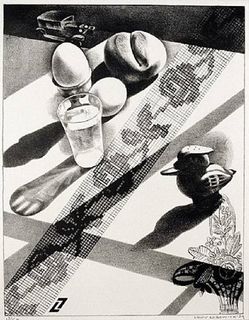 Louis Lozowick (American, b. Ukraine, 1892-1973), "Still Life with Breakfast," 1929. Lithograph, 10 3/8 x 8 in.
Louis Lozowick (American, b. Ukraine, 1892-1973), "Still Life with Breakfast," 1929. Lithograph, 10 3/8 x 8 in.
Stuart Davis (1892-1964) is perhaps the most well-known artist in the show. He exhibited as part of the legendary 1913 Armory Show—which introduced American audiences to European Impressionists, Fauvists and Cubists—when he was only 21 years old. He was, at least during the “Red Decade,” close to the Communist Party, but he never showed any interest in the Stalinist line on art. The exhibit includes one of Davis’s typically jazz-influenced modernist works, the 1939 lithograph New Jersey Landscape.
An entire section of the NYU exhibition comes under the heading of “The Popular Front.” In terms of historical context, this is perhaps the weakest part of the show. The prominent wall caption explains that the John Reed Clubs were closed down and in 1936, “former John Reed Club members organized the call for an American Artists Congress…as a more inclusive artists’ collective with new goals.” It goes on to explain, “The American Artists Congress reflected a changed political program for the international left.” The purpose of the Popular Front was “to build an international coalition among Communists, Socialists, Democrats and independent leftists of all persuasions.”
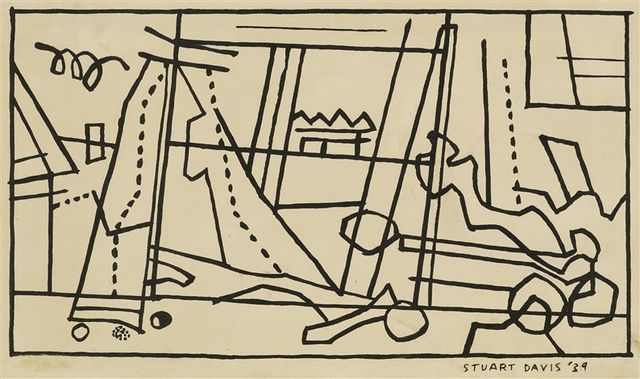 Stuart Davis, (American, b. Philadelphia, PA., 1892-1964), "New Jersey Landscape (Seine Cart)," 1939, 7.63 x 13.63 in.
Stuart Davis, (American, b. Philadelphia, PA., 1892-1964), "New Jersey Landscape (Seine Cart)," 1939, 7.63 x 13.63 in.
This is a serious falsification of the nature of the Popular Front, why it came into being and how it functioned. The “international left” referred to by the curators was the Stalinist apparatus and its counterrevolutionary operations all over the world. While it pursued a coalition with “democratic” imperialists like Roosevelt, virtually the entire leadership of the October Revolution was framed up and executed in the infamous Moscow Trials of 1936-38. The Popular Front was not separate from this drowning of the revolution in blood. In Spain GPU assassins murdered left-wing critics such as Andres Nin and Trotsky’s secretary Erwin Wolf, in a crucial element of the Stalinists’ betrayal of the Spanish Revolution. In the US the explosive CIO movement was brought firmly under the control of the Democratic Party, with the Stalinists playing a crucial role.
It should be noted that the shutting down of the John Reed Clubs paralleled the shift inside the Soviet Union from the Third Period line in which “proletarian culture” was the official doctrine. Without fundamentally altering the theoretical framework, the Stalinist cultural dictators now insisted on “socialist realism,” which prescribed “uplifting” work that was above all aimed at glorifying Stalin and the bureaucratic apparatus.
As for those who strayed from this diktat, their treatment was most prominently illustrated by the violent attacks on composer Dmitri Shostakovich and his opera Lady Macbeth of Mtsensk in 1936. The Soviet experimental theater director Vsevolod Meyerhold was arrested in 1939 and executed the following year. Many lesser-known artists in the USSR suffered the same fate, or simply retreated into silence.
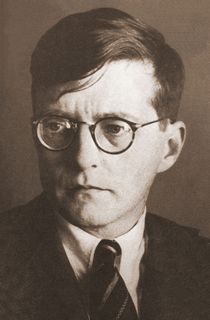 Dmitri Shostakovich
Dmitri Shostakovich
Outside the Soviet Union, a somewhat looser approach was—or had to be—taken, in line with the needs of Moscow’s foreign policy. There was greater leeway for artists like Davis, Lozowick, Miller, Bishop and others, as long as they made no political criticisms.
The “historical backdrop” provided by this exhibition says nothing about any of this. Instead these years are celebrated as the heyday of “activist art” of the 1930s. While it briefly mentions aesthetic differences, they are not developed and above all are not related to the shifts in Stalinist policy during this decade.
Clearly the sympathies of the curators are with the liberals who welcomed an alliance with the Stalinists, an alliance directed against the working class. That is why, after ignoring the Stalinist crimes in the USSR, Spain and elsewhere, the exhibition suddenly explains that the “Red Decade” ended in disappointment with the announcement of the Stalin-Hitler nonaggression pact in August 1939. The membership of the AAC quickly plummeted, reflecting the disaffection of its liberal members as well as the confusion of Communist Party supporters. The liberals were generally unmoved by the Moscow Trials (or approved of them), but the disruption of the US-Soviet alliance was another matter.
The primary impression left by the curators of this exhibition, especially in its concluding sections, is nostalgia for the Popular Front. If only Stalin had not temporarily allied himself with Hitler, they seem to say, the “activist” artists of the 1930s could have continued their work.
Politically this means a continuing orientation, 75 years later, to the capitalist Democratic Party, the line now pursued by the pseudo-left. Aesthetically it suggests an uncritical revival of what passes for “populist” art, today focused largely on identity politics as well as various forms middle-class protest.
The enormous struggles impending against poverty, inequality and the threat of world war will doubtless give birth to new artistic trends. The main lesson to be taken from “The Left Front” exhibition is that it will be necessary to fight against contemporary versions of “pock-marked” art. For all those who wish to confront the question, “What is revolutionary art?” there is no substitute for a serious study of Trotsky and the work of the Trotskyist movement on the issues of culture and revolution.
No comments:
Post a Comment